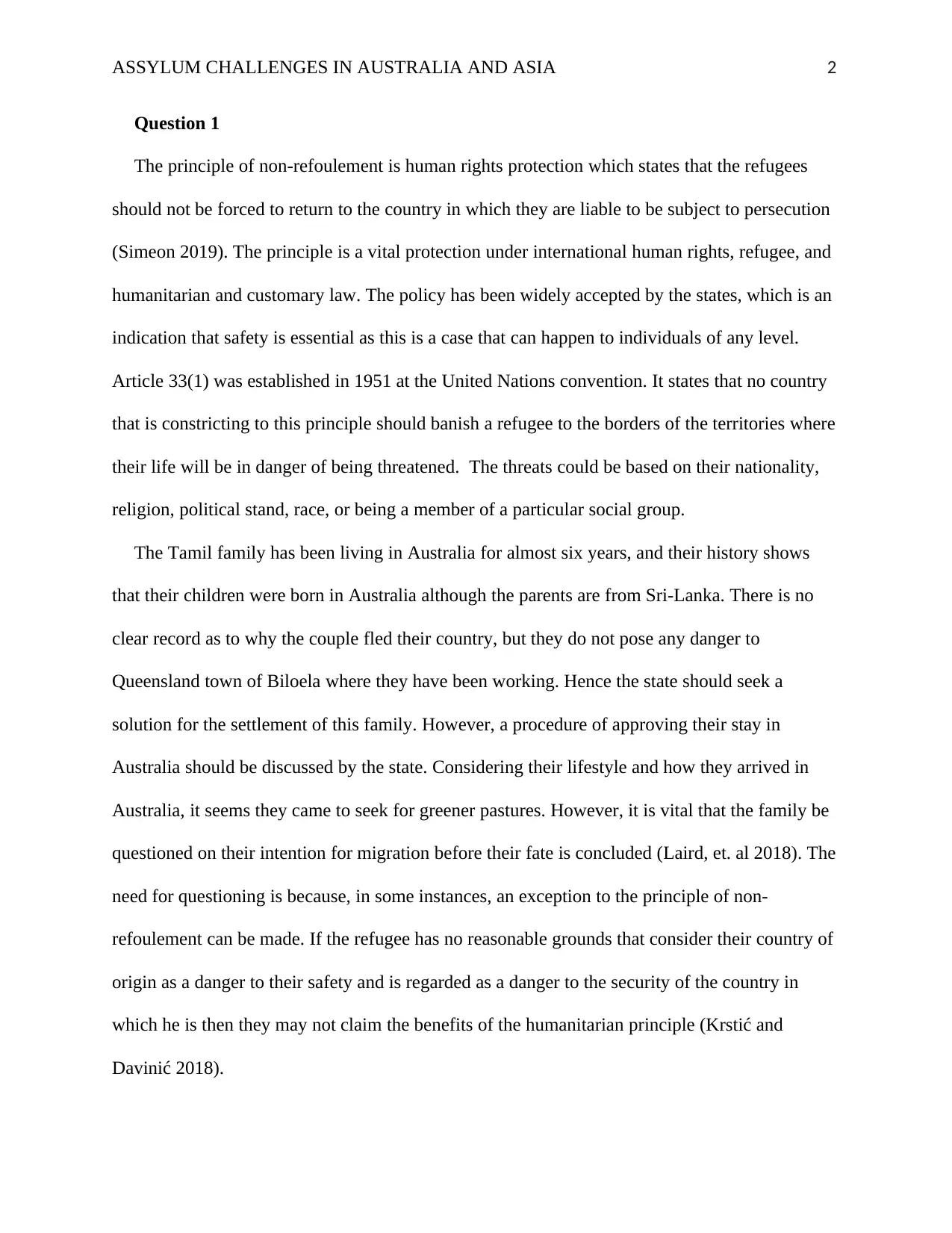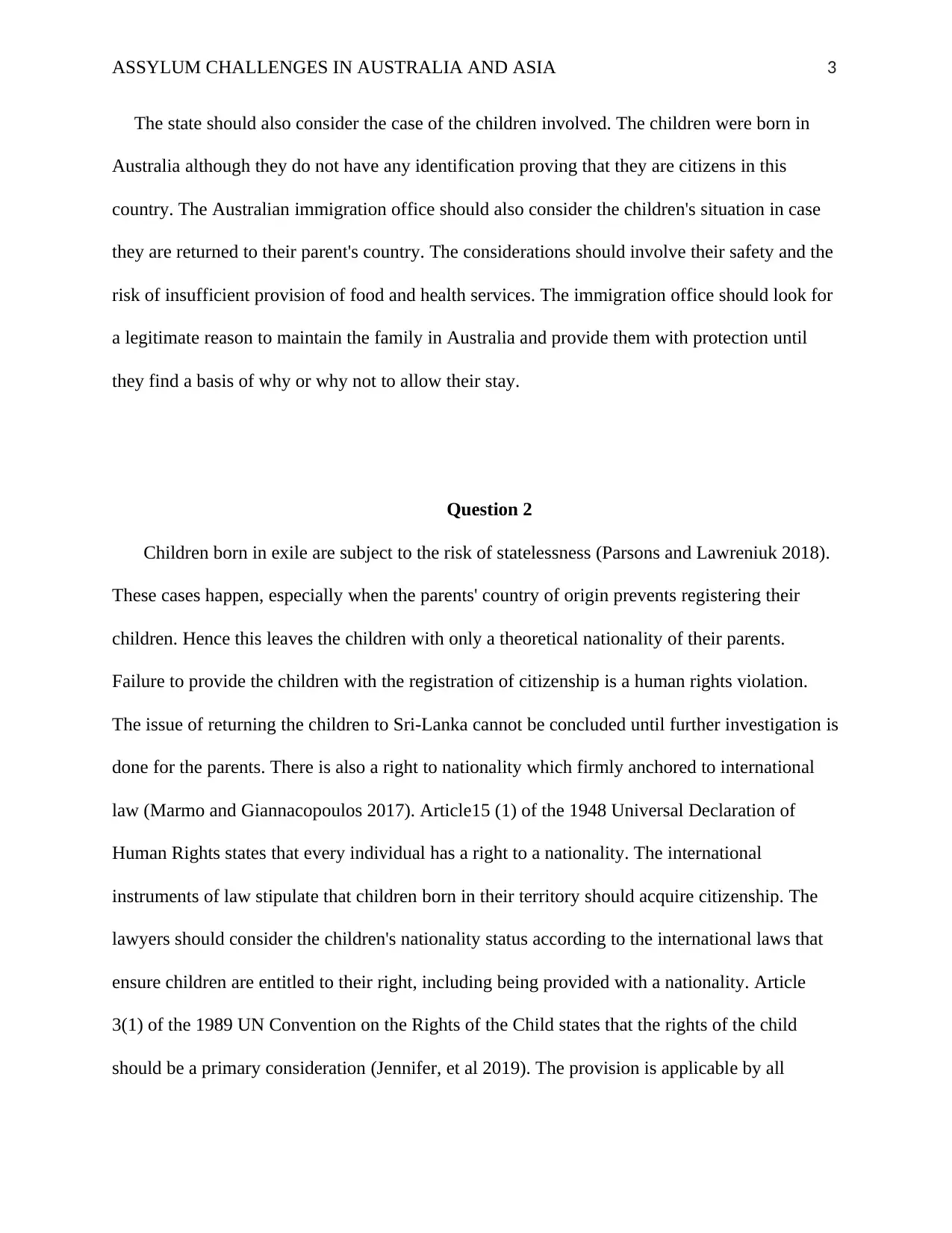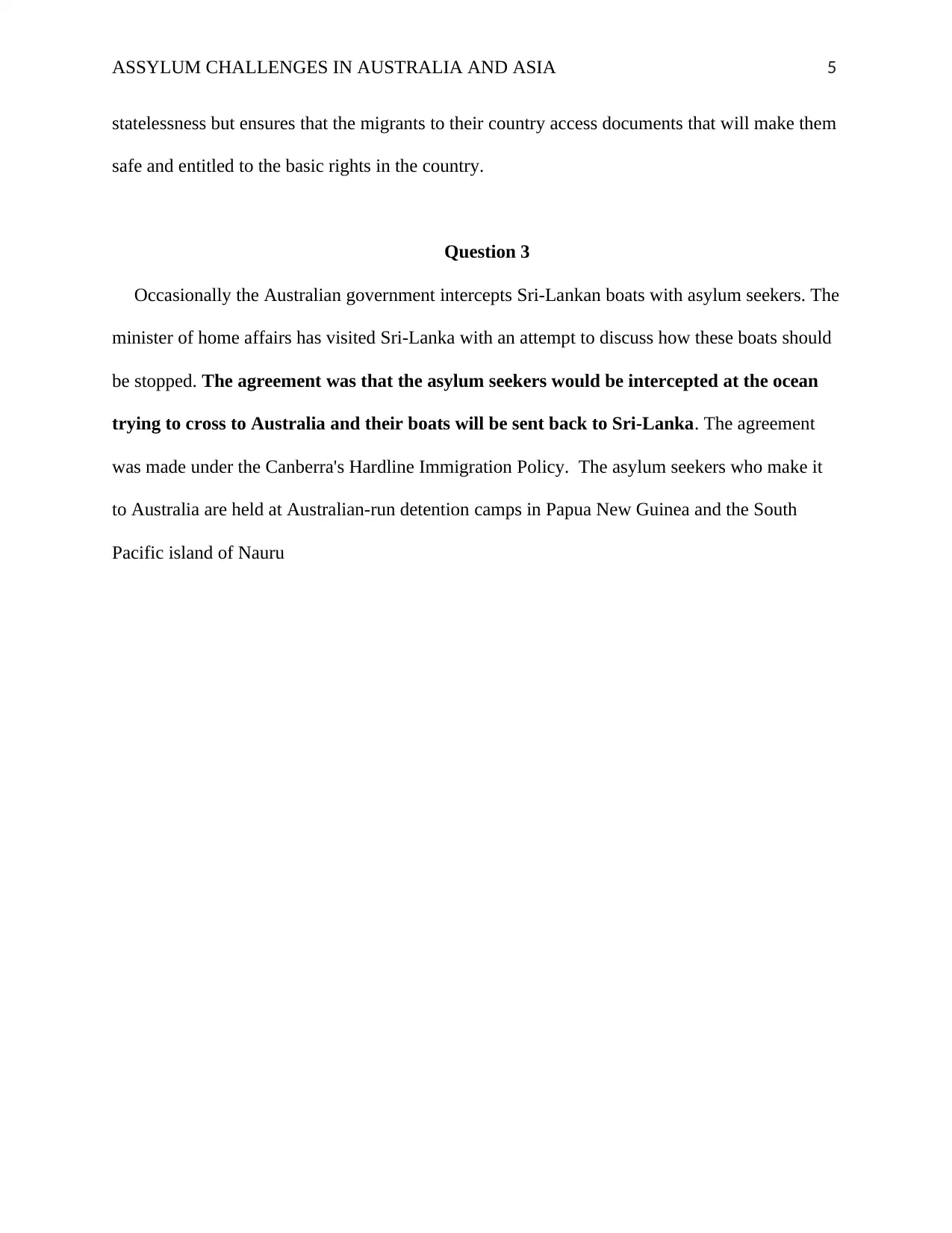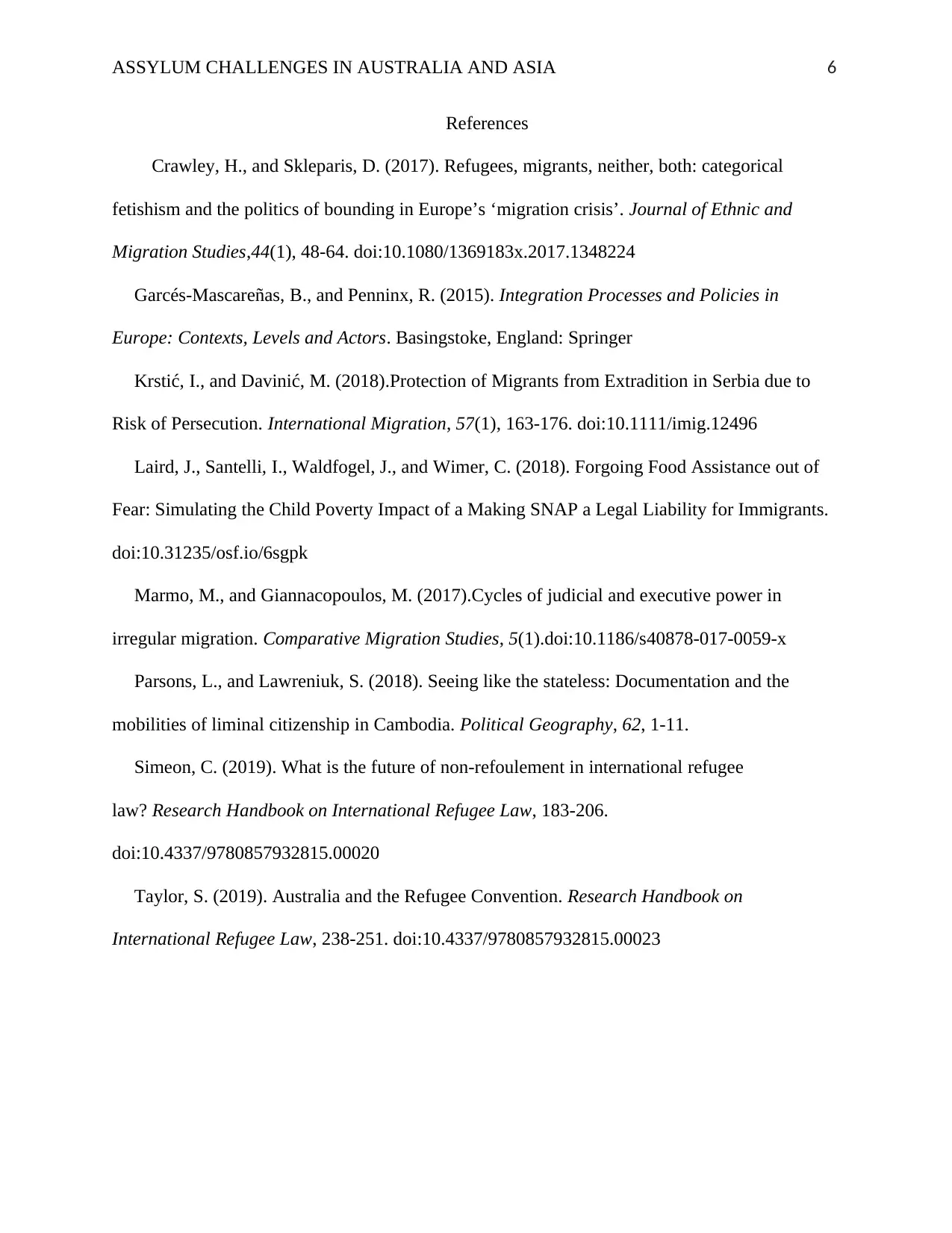Legal Analysis: Asylum Challenges in Australia and Asia
VerifiedAdded on 2022/10/19
|6
|1455
|258
Report
AI Summary
This report examines the asylum challenges faced by Australia and Asian countries, focusing on a specific case of a Tamil family from Sri Lanka. The analysis begins with the principle of non-refoulement, its significance under international law, and its application to the family's situation. It explores the potential exceptions to this principle and the considerations for the children involved. The report then delves into the issue of statelessness for children born in exile and the relevant international laws, including the right to nationality and the UN Convention on the Rights of the Child. Finally, it addresses the Australian government's interception of asylum seeker boats from Sri Lanka and the associated immigration policies. The report considers the ethical and legal implications of these actions, offering a comprehensive overview of the complexities surrounding asylum and immigration in the region.

ASSYLUM CHALLENGES IN AUSTRALIA AND ASIA 1
Asylum challenges in Australia and Asia
Name
Institution
Date
Asylum challenges in Australia and Asia
Name
Institution
Date
Paraphrase This Document
Need a fresh take? Get an instant paraphrase of this document with our AI Paraphraser

ASSYLUM CHALLENGES IN AUSTRALIA AND ASIA 2
Question 1
The principle of non-refoulement is human rights protection which states that the refugees
should not be forced to return to the country in which they are liable to be subject to persecution
(Simeon 2019). The principle is a vital protection under international human rights, refugee, and
humanitarian and customary law. The policy has been widely accepted by the states, which is an
indication that safety is essential as this is a case that can happen to individuals of any level.
Article 33(1) was established in 1951 at the United Nations convention. It states that no country
that is constricting to this principle should banish a refugee to the borders of the territories where
their life will be in danger of being threatened. The threats could be based on their nationality,
religion, political stand, race, or being a member of a particular social group.
The Tamil family has been living in Australia for almost six years, and their history shows
that their children were born in Australia although the parents are from Sri-Lanka. There is no
clear record as to why the couple fled their country, but they do not pose any danger to
Queensland town of Biloela where they have been working. Hence the state should seek a
solution for the settlement of this family. However, a procedure of approving their stay in
Australia should be discussed by the state. Considering their lifestyle and how they arrived in
Australia, it seems they came to seek for greener pastures. However, it is vital that the family be
questioned on their intention for migration before their fate is concluded (Laird, et. al 2018). The
need for questioning is because, in some instances, an exception to the principle of non-
refoulement can be made. If the refugee has no reasonable grounds that consider their country of
origin as a danger to their safety and is regarded as a danger to the security of the country in
which he is then they may not claim the benefits of the humanitarian principle (Krstić and
Davinić 2018).
Question 1
The principle of non-refoulement is human rights protection which states that the refugees
should not be forced to return to the country in which they are liable to be subject to persecution
(Simeon 2019). The principle is a vital protection under international human rights, refugee, and
humanitarian and customary law. The policy has been widely accepted by the states, which is an
indication that safety is essential as this is a case that can happen to individuals of any level.
Article 33(1) was established in 1951 at the United Nations convention. It states that no country
that is constricting to this principle should banish a refugee to the borders of the territories where
their life will be in danger of being threatened. The threats could be based on their nationality,
religion, political stand, race, or being a member of a particular social group.
The Tamil family has been living in Australia for almost six years, and their history shows
that their children were born in Australia although the parents are from Sri-Lanka. There is no
clear record as to why the couple fled their country, but they do not pose any danger to
Queensland town of Biloela where they have been working. Hence the state should seek a
solution for the settlement of this family. However, a procedure of approving their stay in
Australia should be discussed by the state. Considering their lifestyle and how they arrived in
Australia, it seems they came to seek for greener pastures. However, it is vital that the family be
questioned on their intention for migration before their fate is concluded (Laird, et. al 2018). The
need for questioning is because, in some instances, an exception to the principle of non-
refoulement can be made. If the refugee has no reasonable grounds that consider their country of
origin as a danger to their safety and is regarded as a danger to the security of the country in
which he is then they may not claim the benefits of the humanitarian principle (Krstić and
Davinić 2018).

ASSYLUM CHALLENGES IN AUSTRALIA AND ASIA 3
The state should also consider the case of the children involved. The children were born in
Australia although they do not have any identification proving that they are citizens in this
country. The Australian immigration office should also consider the children's situation in case
they are returned to their parent's country. The considerations should involve their safety and the
risk of insufficient provision of food and health services. The immigration office should look for
a legitimate reason to maintain the family in Australia and provide them with protection until
they find a basis of why or why not to allow their stay.
Question 2
Children born in exile are subject to the risk of statelessness (Parsons and Lawreniuk 2018).
These cases happen, especially when the parents' country of origin prevents registering their
children. Hence this leaves the children with only a theoretical nationality of their parents.
Failure to provide the children with the registration of citizenship is a human rights violation.
The issue of returning the children to Sri-Lanka cannot be concluded until further investigation is
done for the parents. There is also a right to nationality which firmly anchored to international
law (Marmo and Giannacopoulos 2017). Article15 (1) of the 1948 Universal Declaration of
Human Rights states that every individual has a right to a nationality. The international
instruments of law stipulate that children born in their territory should acquire citizenship. The
lawyers should consider the children's nationality status according to the international laws that
ensure children are entitled to their right, including being provided with a nationality. Article
3(1) of the 1989 UN Convention on the Rights of the Child states that the rights of the child
should be a primary consideration (Jennifer, et al 2019). The provision is applicable by all
The state should also consider the case of the children involved. The children were born in
Australia although they do not have any identification proving that they are citizens in this
country. The Australian immigration office should also consider the children's situation in case
they are returned to their parent's country. The considerations should involve their safety and the
risk of insufficient provision of food and health services. The immigration office should look for
a legitimate reason to maintain the family in Australia and provide them with protection until
they find a basis of why or why not to allow their stay.
Question 2
Children born in exile are subject to the risk of statelessness (Parsons and Lawreniuk 2018).
These cases happen, especially when the parents' country of origin prevents registering their
children. Hence this leaves the children with only a theoretical nationality of their parents.
Failure to provide the children with the registration of citizenship is a human rights violation.
The issue of returning the children to Sri-Lanka cannot be concluded until further investigation is
done for the parents. There is also a right to nationality which firmly anchored to international
law (Marmo and Giannacopoulos 2017). Article15 (1) of the 1948 Universal Declaration of
Human Rights states that every individual has a right to a nationality. The international
instruments of law stipulate that children born in their territory should acquire citizenship. The
lawyers should consider the children's nationality status according to the international laws that
ensure children are entitled to their right, including being provided with a nationality. Article
3(1) of the 1989 UN Convention on the Rights of the Child states that the rights of the child
should be a primary consideration (Jennifer, et al 2019). The provision is applicable by all
⊘ This is a preview!⊘
Do you want full access?
Subscribe today to unlock all pages.

Trusted by 1+ million students worldwide

ASSYLUM CHALLENGES IN AUSTRALIA AND ASIA 4
measures regarding the nationality of children and the avoidance of statelessness. Therefore the
Australia immigration officer should ensure that the children acquire their nationality documents
from his office. Either way to which the parent's case will be concluded the children should not
be denied their right to Australian nationality.
The problem with statelessness is that the children will not be able to enjoy the full benefits
of national and international legal protection (Crawley and Skleparis 2017). Statelessness may
also deny the children the rights to fundamental rights such as health, education, and political
choice. In case the children live either Australia or Sri-Lanka without acquiring a nationality,
they might be affected by the political future of the country. Some nations acquire new political
systems that might not accommodate migrants. Therefore they may also be stripped off their
rights such as citizenship and have their property seized from them and eventually pushed out of
the country (Garcés-Mascareñas & Penninx 2015).
Australia complied with the 1954 and 1961 statelessness conventions in 1973. Hence the
country has the responsibility to provide stateless people assured rights and privileges to prevent
and reduce statelessness. Australia is a member of the International Covenant on Civil and
Political Rights. The country is also a member of the Convention on the Rights of the Child and
the International Convention on the Elimination of All Forms of Racial Discrimination. Australia
is also involved in the international treaties which assert the children's rights to obtain nationality
and proscribe inequity in the issuing of citizenship. Australia also has settlers who are stateless,
and they have gained residence through the refugee and the humanitarian program. Some
individuals are granted visas under the humanitarian refugee program while others have been
given permanent residence under the same program (Taylor 2019). Australia does not prevent
measures regarding the nationality of children and the avoidance of statelessness. Therefore the
Australia immigration officer should ensure that the children acquire their nationality documents
from his office. Either way to which the parent's case will be concluded the children should not
be denied their right to Australian nationality.
The problem with statelessness is that the children will not be able to enjoy the full benefits
of national and international legal protection (Crawley and Skleparis 2017). Statelessness may
also deny the children the rights to fundamental rights such as health, education, and political
choice. In case the children live either Australia or Sri-Lanka without acquiring a nationality,
they might be affected by the political future of the country. Some nations acquire new political
systems that might not accommodate migrants. Therefore they may also be stripped off their
rights such as citizenship and have their property seized from them and eventually pushed out of
the country (Garcés-Mascareñas & Penninx 2015).
Australia complied with the 1954 and 1961 statelessness conventions in 1973. Hence the
country has the responsibility to provide stateless people assured rights and privileges to prevent
and reduce statelessness. Australia is a member of the International Covenant on Civil and
Political Rights. The country is also a member of the Convention on the Rights of the Child and
the International Convention on the Elimination of All Forms of Racial Discrimination. Australia
is also involved in the international treaties which assert the children's rights to obtain nationality
and proscribe inequity in the issuing of citizenship. Australia also has settlers who are stateless,
and they have gained residence through the refugee and the humanitarian program. Some
individuals are granted visas under the humanitarian refugee program while others have been
given permanent residence under the same program (Taylor 2019). Australia does not prevent
Paraphrase This Document
Need a fresh take? Get an instant paraphrase of this document with our AI Paraphraser

ASSYLUM CHALLENGES IN AUSTRALIA AND ASIA 5
statelessness but ensures that the migrants to their country access documents that will make them
safe and entitled to the basic rights in the country.
Question 3
Occasionally the Australian government intercepts Sri-Lankan boats with asylum seekers. The
minister of home affairs has visited Sri-Lanka with an attempt to discuss how these boats should
be stopped. The agreement was that the asylum seekers would be intercepted at the ocean
trying to cross to Australia and their boats will be sent back to Sri-Lanka. The agreement
was made under the Canberra's Hardline Immigration Policy. The asylum seekers who make it
to Australia are held at Australian-run detention camps in Papua New Guinea and the South
Pacific island of Nauru
statelessness but ensures that the migrants to their country access documents that will make them
safe and entitled to the basic rights in the country.
Question 3
Occasionally the Australian government intercepts Sri-Lankan boats with asylum seekers. The
minister of home affairs has visited Sri-Lanka with an attempt to discuss how these boats should
be stopped. The agreement was that the asylum seekers would be intercepted at the ocean
trying to cross to Australia and their boats will be sent back to Sri-Lanka. The agreement
was made under the Canberra's Hardline Immigration Policy. The asylum seekers who make it
to Australia are held at Australian-run detention camps in Papua New Guinea and the South
Pacific island of Nauru

ASSYLUM CHALLENGES IN AUSTRALIA AND ASIA 6
References
Crawley, H., and Skleparis, D. (2017). Refugees, migrants, neither, both: categorical
fetishism and the politics of bounding in Europe’s ‘migration crisis’. Journal of Ethnic and
Migration Studies,44(1), 48-64. doi:10.1080/1369183x.2017.1348224
Garcés-Mascareñas, B., and Penninx, R. (2015). Integration Processes and Policies in
Europe: Contexts, Levels and Actors. Basingstoke, England: Springer
Krstić, I., and Davinić, M. (2018).Protection of Migrants from Extradition in Serbia due to
Risk of Persecution. International Migration, 57(1), 163-176. doi:10.1111/imig.12496
Laird, J., Santelli, I., Waldfogel, J., and Wimer, C. (2018). Forgoing Food Assistance out of
Fear: Simulating the Child Poverty Impact of a Making SNAP a Legal Liability for Immigrants.
doi:10.31235/osf.io/6sgpk
Marmo, M., and Giannacopoulos, M. (2017).Cycles of judicial and executive power in
irregular migration. Comparative Migration Studies, 5(1).doi:10.1186/s40878-017-0059-x
Parsons, L., and Lawreniuk, S. (2018). Seeing like the stateless: Documentation and the
mobilities of liminal citizenship in Cambodia. Political Geography, 62, 1-11.
Simeon, C. (2019). What is the future of non-refoulement in international refugee
law? Research Handbook on International Refugee Law, 183-206.
doi:10.4337/9780857932815.00020
Taylor, S. (2019). Australia and the Refugee Convention. Research Handbook on
International Refugee Law, 238-251. doi:10.4337/9780857932815.00023
References
Crawley, H., and Skleparis, D. (2017). Refugees, migrants, neither, both: categorical
fetishism and the politics of bounding in Europe’s ‘migration crisis’. Journal of Ethnic and
Migration Studies,44(1), 48-64. doi:10.1080/1369183x.2017.1348224
Garcés-Mascareñas, B., and Penninx, R. (2015). Integration Processes and Policies in
Europe: Contexts, Levels and Actors. Basingstoke, England: Springer
Krstić, I., and Davinić, M. (2018).Protection of Migrants from Extradition in Serbia due to
Risk of Persecution. International Migration, 57(1), 163-176. doi:10.1111/imig.12496
Laird, J., Santelli, I., Waldfogel, J., and Wimer, C. (2018). Forgoing Food Assistance out of
Fear: Simulating the Child Poverty Impact of a Making SNAP a Legal Liability for Immigrants.
doi:10.31235/osf.io/6sgpk
Marmo, M., and Giannacopoulos, M. (2017).Cycles of judicial and executive power in
irregular migration. Comparative Migration Studies, 5(1).doi:10.1186/s40878-017-0059-x
Parsons, L., and Lawreniuk, S. (2018). Seeing like the stateless: Documentation and the
mobilities of liminal citizenship in Cambodia. Political Geography, 62, 1-11.
Simeon, C. (2019). What is the future of non-refoulement in international refugee
law? Research Handbook on International Refugee Law, 183-206.
doi:10.4337/9780857932815.00020
Taylor, S. (2019). Australia and the Refugee Convention. Research Handbook on
International Refugee Law, 238-251. doi:10.4337/9780857932815.00023
⊘ This is a preview!⊘
Do you want full access?
Subscribe today to unlock all pages.

Trusted by 1+ million students worldwide
1 out of 6
Related Documents
Your All-in-One AI-Powered Toolkit for Academic Success.
+13062052269
info@desklib.com
Available 24*7 on WhatsApp / Email
![[object Object]](/_next/static/media/star-bottom.7253800d.svg)
Unlock your academic potential
Copyright © 2020–2025 A2Z Services. All Rights Reserved. Developed and managed by ZUCOL.





